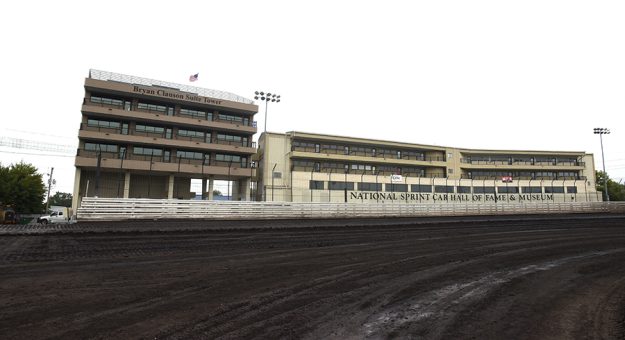As National Sprint Car Hall of Fame and Museum Executive Director Bob Baker pulls into work, it is not difficult for him to reminisce about his first trips to Knoxville, Iowa.
As National Sprint Car Hall of Fame and Museum Executive Director Bob Baker pulls into work, it is not difficult for him to reminisce about his first trips to Knoxville, Iowa.
“My brother and I would come up from Kansas City as teenagers to watch the races,” Baker said. “It was a lot different than it is now. There was no pavement behind the grandstands which were much smaller than today and there was nothing but Quonset huts behind turn two.”
Notably absent was the National Sprint Car Hall of Fame building and the Bryan Clauson Tower now resting outside of the second turn.

There was the time when many considered the creation of the physical Hall of Fame building as nothing but a pipedream. There were doubters galore and the project had the expected fits and starts before ground was broken and the first visitors walked through the front door.
Tom Schmeh served as executive director from 1989 through 2008 and then spent nine additional years as the curator. Schmeh made his first trip to the Knoxville Nationals in 1985, where he heard of the plans to create a National Sprint Car Hall of Fame and Museum and his interest was piqued. He quickly pulled Knoxville Raceway leader Ralph Capitani aside and expressed an interest in being involved.
The first steps taken to breathe life into this project was the creation of a task force to explore all available options. Baker noted that it was not fait accompli that the Hall of Fame would be in Knoxville. “There was a lot of debate on where the Hall of Fame should be built,” he said. “Should it be built in California? There is so much open-wheel racing history in California, and even today a major percentage of our Hall of Fame inductees come from there. Should it be built in Pennsylvania? Everyone knows that is a hotbed of sprint car racing. Then you had Knoxville, which had the Knoxville Nationals and weekly sprint car racing.”
The task force evolved into a formal Board of Directors that included attorney Cary Agajanian, the son of the legendary J.C. Agajanian, Harold Annett, Iowa businessman and sprint car owner, Nebraska‘s “Speedy” Bill Smith, Eunice Kuyper of the Pella Corporation, Casey‘s General Store founder Don Lamberti and Schmeh who was working in the motorsports arm of the Miller Brewing Co.
Completing the necessary paperwork, the project secured 5013c status. G. Wayne Hall was named the first executive director of the Hall of Fame, but a little more than a year later, Schmeh had been appointed to that position.

But the heavy lifting remained. With an agreement that the Hall of Fame would reside in Knoxville the question of where to locate the physical structure remained undecided. Several sites were examined until Lamberti led the group to make the decision to build the facility next to the race track outside of turn two. He reasoned that, if the Hall of Fame was built next to the track, suites could be built on top of it, creating an added revenue stream.
Baker recalled a poignant moment in the early days of his tenure as executive director. Lamberti asked to have a private conversation, and he didn‘t pull a punch. “Don says I have a question for you,” Bob recalls with a chuckle, “Have you ever run a non-profit business before? I said, ‘No, I haven‘t.‘ Don said, ‘Let me tell you something, they all lose money. Every one of them. Your job is to make sure this museum brings in enough money to keep that front door open. It was what Bob Baker needed to hear to this day.”
To even install a front door took benefactors such as Lamberti and the late Lee Barfield, who worked diligently to recruit investors. The project was launched during the farm crisis, with states such as Iowa hit hard.
Tom Schmeh, and Lori DeMoss, who is still involved with the Hall of Fame to this day, routinely deferred their pay to keep the ball moving forward. By 1991 construction, which had been halted, resumed and Schmeh sold three-year leases for the first 20 suites. The grand opening came on Jan. 2, 1992.
Schmeh and Baker maintain that the Hall of Fame‘s stated mission — to promote the future by preserving the past — has never changed.

“Right from the beginning we had a dual mission,” Schmeh said, “and we had two programs that fulfilled that mission. One was the National Sprint Car Poll, which focuses on the current achievers of the sport. Here we recognize the best in 410, 360 and non-wing sprint racing for the past year. The other half of the dual mission is the National Sprint Car Hall of Fame honoring the greatest achievers of the sport.”
Since 1990, inductees represent distinct categories and include drivers, owners and mechanics, promoters, sponsors and media members.
The other consistent message is one of inclusiveness.
“We are a place where everyone is welcome,” Baker said. “It doesn‘t matter if you are winged or non-winged, carbureted or two barrel or four barrels, it is for everyone, it is for all types of sprint car racing.”
Schmeh concurred. “Right from the beginning we wanted to be the umbrella organization for the betterment of the sport,” he said. “So we made an honest effort to reach out to different sanctioning bodies and different tracks even to the teams and owners, drivers and mechanics. We tried to be that focal point because our sport doesn‘t have a controlling body. We wanted to bring people together.”
